An improved AMBER force field for α,α-dialkylated peptides: intrinsic and solvent-induced conformational preferences of model systems
Abstract
α,α-Dialkylated amino acid residues have acquired considerable importance as effective means for introducing backbone conformation constraints in synthetic peptides. The prototype of such a class of residues, namely Aib (α-aminoisobutyric acid), appears to play a dominant role in determining the preferred conformations of host proteins. We have recently introduced into the standard AMBER force field some new parameters, fitted against high-level quantum mechanical (QM) data, for simulating peptides containing α,α-dialkylated residues with cyclic side chains, such as TOAC (TOAC, 2,2,6,6-tetramethylpiperidine-1-oxyl-4-amino-4-carboxylic acid) and Ac6c (Ac6c = 1-aminocyclohexaneacetic acid). Here, we show that in order to accurately reproduce the observed conformational geometries and structural fluctuations of linear α,α-dialkylated peptides based on Aib, further improvements of the non-bonding and side chain torsion potential parameters have to be considered, due to the expected larger structural flexibility of linear residues with respect to cyclic ones. To this end, we present an extended set of parameters, which have been optimized by fitting the energies of multiple conformations of the Aib dipeptide analogue to corresponding QM calculations that properly account for dispersion interactions (B3LYP-D3). The quality, transferability and size-consistency of the proposed force field have been assessed both by considering a series of poly-Aib peptides, modeled at the same QM level, and by performing molecular dynamics simulations in solvents with high and low polarity. As a result, the present parameters allow one to reproduce with good reliability the available QM and experimental data, thus representing a notable improvement over current force field especially in the description of the α/310-helix conformational equilibria of α,α-dialkylated peptides with linear and cyclic side chains.


 Please wait while we load your content...
Please wait while we load your content...